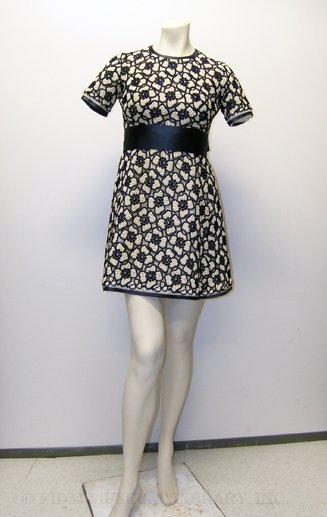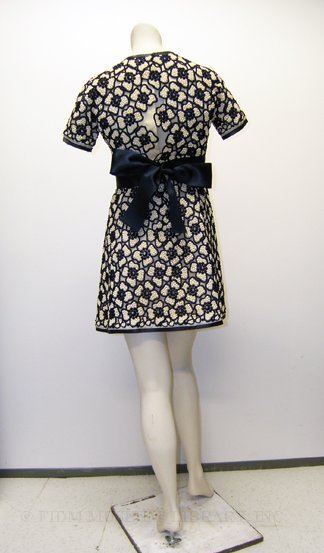Yves Saint Laurent mini-dress, c. 1967
Yves Saint Laurent had a talent for translating street fashion into the vocabulary of the haute couture. He demonstrated this ability early, during his brief tenure as head designer at Christian Dior. Inspired by the bohemian students, artists and intellectuals who frequented the Left Bank of Paris, Saint Laurent designed the 1960 Beat collection. Filled with black clothing, including turtlenecks, leather suits and a mink-trimmed crocodile jacket, the collection was an affront to the refined sensibilities of haute couture clients and fashion editors. Though it led to Saint Laurent's departure from Christian Dior, the Beat collection was a glimpse into the future of fashion. Saint Laurent had recognized that the fashion dictates of the haute couture were becoming irrelevant. By combining elements of street style with haute couture production techniques, Saint Laurent energized an insular world.

Mini-dress
C. 1967
Yves Saint Laurent
Gift of Laura Jarre
99.384.1A-C
After the Beat collection bombed, Saint Laurent was drafted into the French military in the fall of 1960. Traumatized by military life, the designer had a breakdown and was discharged a few months later. After recovering his health and psyche, Saint Laurent launched his own house in 1961, presenting his first collection in January 1962. Within a few years, Saint Laurent was designing innovative, wearable collections that referenced the preoccupations of popular culture, while also appealing to haute couture clients. His Mondrian shift dresses and Pop Art collections of the mid-1960s responded to changes in the art world, while his Le Smoking trouser suit acknowledged that women were hungry for alternatives to dresses and skirts. Recognizing that lower prices might attract customers with more daring than his haute couture clients, in 1967 Saint Laurent founded Rive Gauche, a ready-to-wear line.
A haute couture design, this Saint Laurent mini-dress dates from the late 1960s. Blue and white floral lace rests over layers of transparent organza and white gazar. The collar, sleeves and hem are trimmed with navy blue silk satin and a belt of the same fabric completes the dress. Lined entirely in cream silk, the dress conforms to a provocative Catherine Deneuve comment: "When you put something on from Yves Saint Laurent's couture, there is an immediate sensual experience: everything, no matter what it is made of, is always lined in silk satin."1

In the image above, note how the floral lace separates at the center back seam. Instead of inserting a zipper, Saint Laurent allowed the natural shape of each flower to dictate the closure. Small snaps hook the flowers together and create a seamless appearance. Flowers were a predominant motif throughout the 1960s, decorating garments, accessories and innumerable household goods. Suggesting girlish innocence in the first half of the decade, flower power became a mantra of the anti-war and student protests later in the decade.
At the time Saint Laurent designed this mini-dress, flowers were still associated with an optimistic outlook. As political protests grew more contentious and violent, Saint Laurent responded to the darkening mood by designing garments with a military feel, including khaki trouser suits. The shifting political and social climate powerfully affected his outlook and aesthetic. In 1968, after encountering the protesters of Paris, Saint Laurent declared: "Recent political events make the Haute Couture a relic of the past."2
1 Quoted in Vreeland, Diana. Yves Saint Laurent. New York: Metropolitan Museum of Art. 1983: 34-5.
2 Quoted in Steele, Valerie. Fifty Years of Fashion: New Look to Now. New Haven: Yale University Press. 1997: 68.